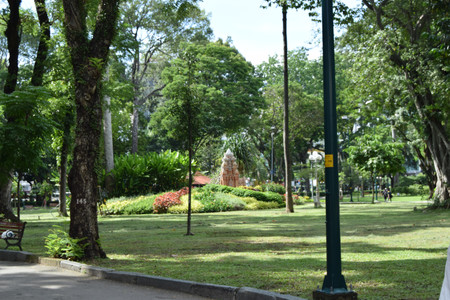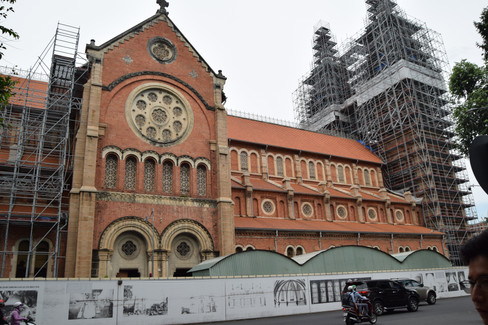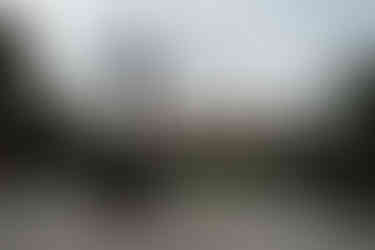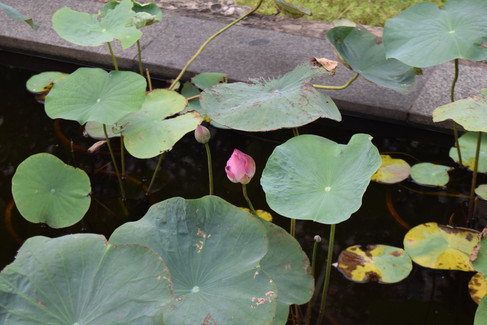Day 06 - Tunnels, Iced Coffee and Millions of Scooters!
- SElliott

- Jan 7
- 6 min read
Updated: Jan 16
Today is our first, and only, full day in Ho Chi Minh City. I continued with Tai Chi this morning - I’m trying to get in a habit for when I go home. Then it was down to the ground floor for breakfast before heading out to the buses for our visit to the Cu Chi tunnels.
On the way to the Tunnels we were driven through Ho Chi Minh City. This was originally called Saigon and, although Saigon on refers to the centre of Ho Chi Minh City, many Vietnamese still call the city Saigon rather than Ho Chi Minh City. There are over 13 million people living in Ho Chi Minh City, and over 9 million motorcycles/scooters. Sounds a bit like a Katie Mellua song! We were warned that, although there are zebra crossings and lights, they are mainly just there as decoration and many drivers tend not to take note of them!

Picture 1 – Ho Chi Minh Traffic
The rush hour in Ho Chi Minh City lasts from 6am to 9pm, all year round apart from the Lunar New Year (like the Chinese New Year) which usually lasts for three days. During this time many Vietnamese living in the big cities take the opportunity of the three-day holiday to go and visit family in the country so the cities are very quiet.
We were also told that a lot of Vietnamese ladies cover up completely when riding scooters, wearing full length jackets, hats, sunglasses, face masks and gloves. This is not due to pollution or air quality but to try and keep their skin as white as possible, pale skin is seen as beautiful in Vietnamese culture. On the other hand, men do not want to have pale skin, in case they get mistaken for “lady boys”! Real men have dark skin.
We arrived at Cu Chi district, a district only 30km to 40km from Ho Chi Minh City, mid-morning. The Cu Chi tunnels were constructed originally in late 1940s during the Franco-Vietnam war. They were originally used as bomb shelters for the local populace, for communication between villages and for the Viet Minh to evade the French army. In the 1960s, when the Viet Cong’s (VC’s) National Liberation Front insurgency began in earnest they decided to use and improve the original tunnel system for their use. Eventually there was over 250km of tunnels running underneath Cu Chi District alone, all dug by hand with primitive tools. The tunnels soon became of strategic importance – they were used for mounting attacks against the American forces, facilitating communication and co-ordination between the VC-controlled enclaves and they were used as a base for infiltrating intelligence agents and sabotage teams into Ho Chi Minh City itself.
The Cu Chi area was heavily fought over during the Vietnamese war, and the VC strength in and around Cu Chi was one of the reasons why the Americans joined the war. One of America’s first actions during the war was to establish a large military camp in the Cu Chi district. Unfortunately, they unknowingly built it on top of an existing tunnel network. It took months for the 25th Division to figure out why tey kept getting shot at in their tents at night. After a large number of casualties, and ineffective ground opportunities, the Americans resorted to massive firepower, changing the Cu Chi area into what the authors of The Tunnels of Cu Chi have described as “the most bombed, shelled, gassed, defoliated and generally devastated ar3ea in the history of warfare”.
Eventually, after the Americans had become aware of the tunnels and unable to win the war by superior firepower, the Americans began sending men down into the tunnels. These had to be the smallest American soldiers due to the difference in size between the Vietnamese and them! However, the tunnels were riddled with traps and there were many underground fire fights leading to high American casualties. German shepherd dogs were also used, the VC tricked the dogs into thinking that they were friendly by washing with American soap and wearing captured American uniforms. Also, many dogs were killed or maimed by booby traps, causing their handlers to refuse to send them into the tunnels.
We were visiting a section of the tunnels located in Ben Dinh. The museum complex is in an area of tropical forest with paths winding through the trees. Our guide first showed us one of the hidden entrances, although this one had been enlarged by 30% to allow tourists to try it out! The original was about 6” smaller.
Picture 2 – Cu Chi Tunnel Entrance
We were then shown the different types of booby traps used by the VC – the purpose of these traps was to main rather than to kill as this would mean that the injured man would have to be transported back to base, costing the Americans 3 men instead of 1. The VC also became experts in re-using everything the Americans threw at them! Unexploded shells were, very carefully, stripped and the explosive and metal casing used to make mines and grenades; car tires were used for sandals. The sandals were made with no glue and were designed to be worn so that the shape of the sole would make it seem as if you were travelling in the opposite direction!

Picture 3 – Sandal Making
The last part of the tour was through a 20m section of the tunnels, the steps down (and up) were quite deep and to get through the tunnels you either had to bend almost double or go on your hands and knees! I tried to video it but my video didn’t record! What a missed opportunity.
We returned to Ho Chi Minh before lunch, which we had to source ourselves, before our Ho Chi Minh City Walk. This started by taking us through Cong Vien Van Hoa Park, stopping for a moment in front of the golden tomb of King Hung Vuong. This park reminded me very much of French parks with its’ wide paths shaded by trees and sculptures dotted around.
Picture 4 – Cong Vien Van Hoa Park
From the park we walked around to the Reunification Palace, this was once the symbol of the South Vietnamese Presidents until the North Vietnam forces captured what was then Saigon and today is Ho Chi Minh City. When the VC dramatically crashed through the wrought-iron gates, in a tank, the head of the South Vietnamese State, General Minh was waiting with his improvised cabinet. “I have been waiting since early this morning to transfer power to you” the President, of less than two days, said to the VC officer who entered the room. “There is no question of your transferring power” replied the officer, “you cannot give up what you do not have”.

Picture 5 – Reunification Palace
Since Hanoi is the seat of the Vietnamese Government, this palace is now only used for official receptions or meetings.
Our next point of interest was the neo-Romanesque Notre-Dame Cathedral which is undergoing renovations. Unusually there are no stained glass windows in this cathedral, they were a casualty of World War II. Next to the cathedral is the Main Post Office. A lovely building in the french-style where there are souvenirs and postcards for sale.
Picture 6 – Cathedral and Post Office
From the Post Office we walked to the Colonial Opera House, also known as the municipal theatre, before turning down Lam Son Park to the Peoples Committee Building. This was the former Hôtel de Ville and has a lovely french-style façade. In front of the Peoples Committee Building is another little square with a statue of President Ho Chi Minh, surrounded on three sides by lotus flowers, which I had never seen before.
Picture 7 – Peoples Committee Building and Lotus Flowers
After we had taken all our pictures, we continued with our walk, aiming for a coffee shop near the Ben Thanh market. On our way we passed a typical Vietnamese market – with stall on both sides, there was barely enough room to get a car between them! It makes sense that all the locals prefer scooters and motorbikes. At the coffee shop we enjoyed the air con and an iced coffee, my first. The coffee was made with condensed milk and was quite nice, although stronger than I usually have mine. I might try iced coffee at home when I get back.

Picture 8 – Ho Chi Minh
After enjoying our coffees, and cooling down, it was out into the hot and humid Vietnamese weather again! We continued our walk by traversing through the Ben Thanh market, the central market in Ho Chi Minh City. Before we entered the market we removed our nametags – so that the enterprising stall owners couldn’t identify us and call us by name! Our guide told us that many Vietnamese no longer shop at Ben Thanh Market as the prices have been hiked up to profit off of unsuspecting tourists who visit. If we wanted to buy anything we were told to bargain with the stall owner, aiming for 70% off!

Picture 9 – Ben Thanh Market
From the market it was back to the hotel. On the way back we some Durian – the smelly fruit!
Tonight we had dinner at Home Restaurant. It was nice but I preferred the Home Restaurant in Ha Noi.

Picture 10 – Ho Chi Minh Restaurant





























Comments